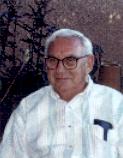

Lester Aufmuth was born in Cleveland, Ohio to Hilda and Louis Aufmuth. He is survived by his wife, Barbara Heintzleman, his sons David, Richard and Nod, his sister Dorothy Towle, five grandchildren, and five great-grandchildren.
Lester enlisted in the Army Air Corps in January 1941. He was stationed at various airbases including Randolph and Ellington Fields in Texas; Santa Ana, Santa Maria, and Lenore Fields in California. He graduated Advanced Flying Field, Class 43A, at Williams Field, AZ.; then took transition training in B17’s at Walla Walla, WA. His B-17 combat training was at Cowen Field, Boise, ID, and then it was off to Kearney, NE. for assignment to the Fortress that he would fly overseas.
After his training was complete, Les and a heavy bomber crew started off on the flight to England. They were delayed one week at Gander, Newfoundland due to fog. Then it was on to Prestwick, Scotland, and finally to Grafton-Underwood base in England. Flight time from Gander to Prestwick was 11 hours and 15 minutes for a distance of 2,300 miles.
Lester was assigned to the 384th Bombardment Group, 545th Squadron. He started his combat career with three bombing runs over German airfields, and a fourth fateful mission to Stuttgart, a ball-bearing factory, on September 6, 1943. Their Fortress ran out of gas near Gisor, France (near the Channel) and crash-landed in a hay field. The crash set their B-17 on fire. A young French girl on a bicycle saw Les and two other crewmembers and took them to her farm. They were hidden in the barn and moved to various Underground locations over the course of one week. They ended up in an apartment in Paris with Anne and Leon Danesnard, and Les was programmed to act as a deaf-mute who had been injured in a factory bombing in case of capture.
The evadees were taken by train to Toulouse, then Lourdes, then back on a train to Banyeiere. Twenty-six people, both military personnel and civilians, climbed the foothills of the Pyranees in freezing weather toward Spanish border. They were intercepted by German border patrol guards a few miles from the border. They were taken to Toulouse Prison, then in chains by rail to Fresnes Prison in Paris. They endured a Gestapo interrogation; then were sent in cattle cars on Christmas Eve to Stalag Luft 1, Barth, in northern Germany, a few miles from the Baltic Sea. While in prison camp, Les helped build an escape tunnel, which came to be named the “Heintz” as it was the 57th tunnel the Germans discovered.
On April 30, 1945 Russian Cossacks on horseback (with their women riding with them) liberated the camp. The German guards had either evacuated the camp or killed themselves and did not want the P.O.W.s liberated, hoping to get them to Russia. An American general sent word that planes would be landing the next day, otherwise WWIII would have started.
On May 5, 1945, B-17s and C-47s arrived and within 24 hours 9,600 men were evacuated. Les was sent to Camp Lucky Strike and then to LeHavre for return home aboard a converted freighter, the Sea Dragon, into Boston Harbor.
Following R&R at Miami Beach, Les was based at Lockbourne AFB in Columbus, Ohio and later at Columbus AFB in Columbus, MS. He left the service in 1946, but stayed in the Reserves for ten more years.In 1975, Lester Aufmuth retired from his vW dealership and moved to Tucson, AZ. In Tucson, he was a volunteer at the Pima Air & Space Museum and at the 390th Bombardment Group Memorial Museum. His presence is missed by family and friends alike.